L11-名称概念词与短语 初中英语词性句法新讲课件(共18张PPT)
文档属性
| 名称 | L11-名称概念词与短语 初中英语词性句法新讲课件(共18张PPT) |  | |
| 格式 | ppt | ||
| 文件大小 | 1.2MB | ||
| 资源类型 | 试卷 | ||
| 版本资源 | 通用版 | ||
| 科目 | 英语 | ||
| 更新时间 | 2022-04-11 06:49:55 | ||
图片预览

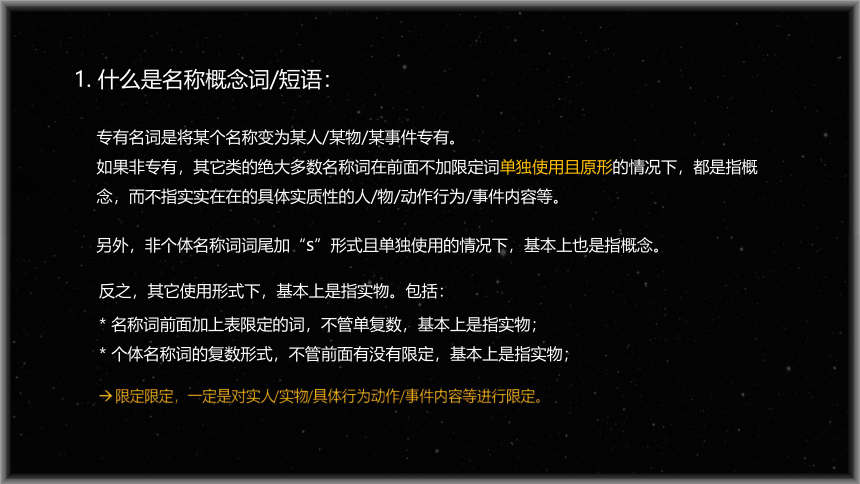
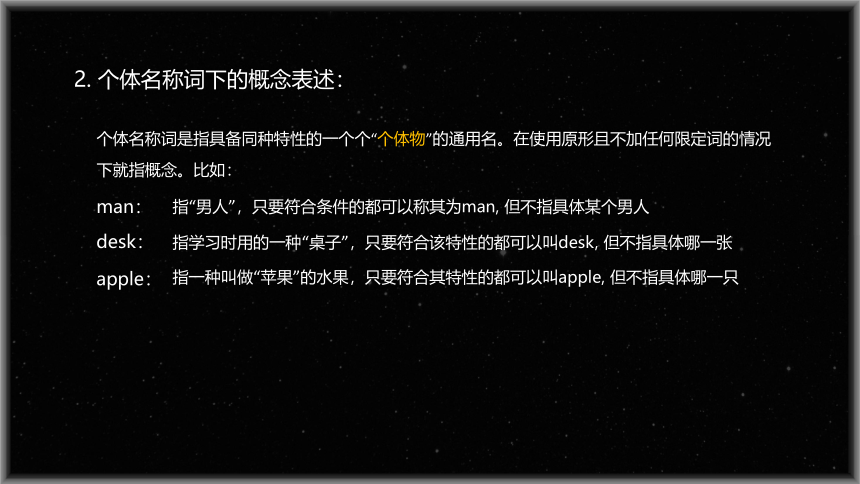
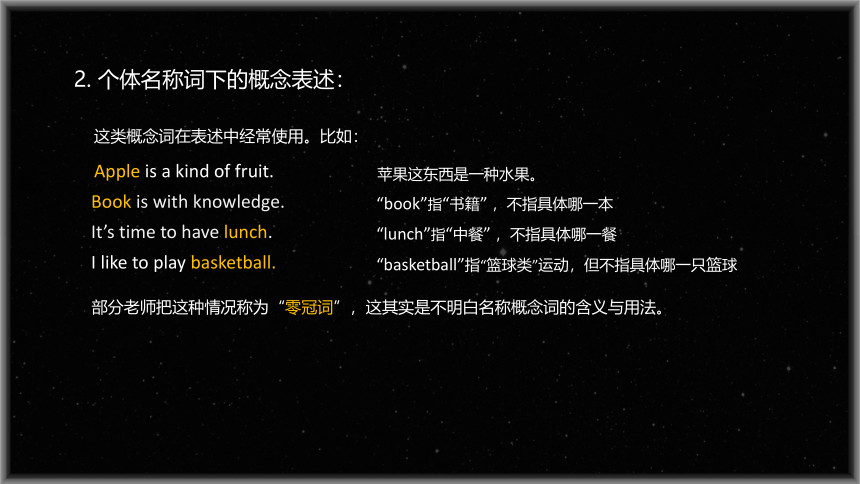
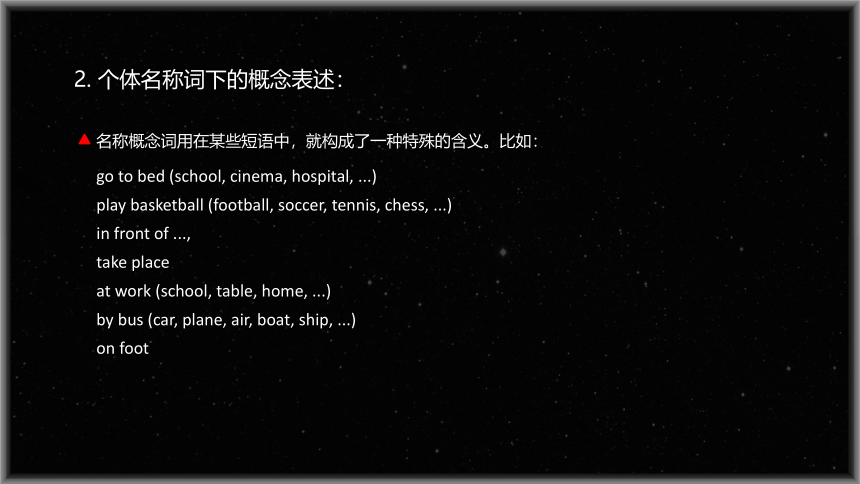
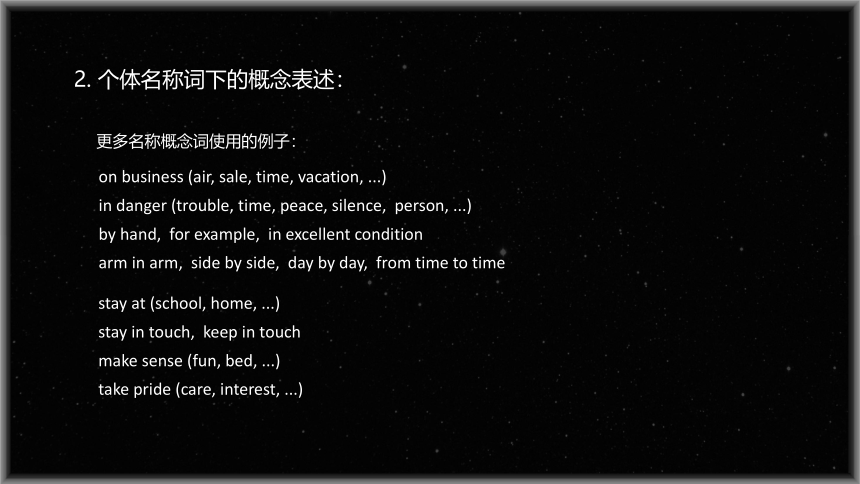
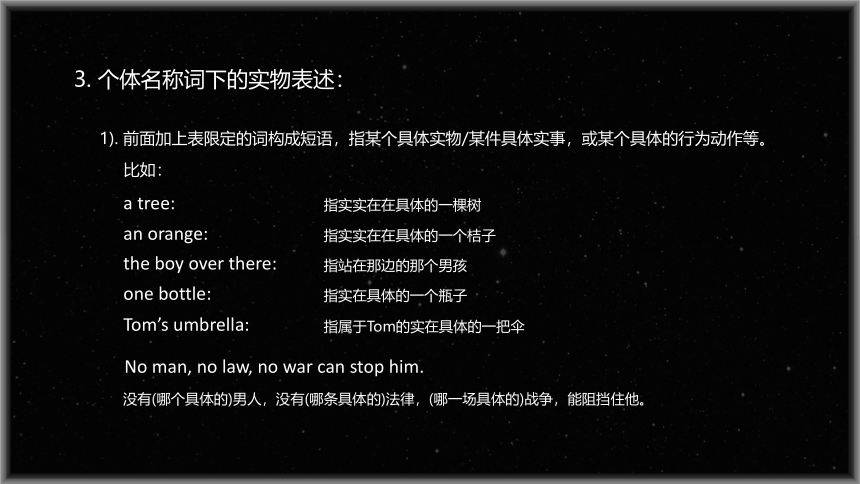
文档简介
(共18张PPT)
名称概念词/短语
Lesson 11:
授课人:曾老师
1. 什么是名称概念词/短语:
专有名词是将某个名称变为某人/某物/某事件专有。
如果非专有,其它类的绝大多数名称词在前面不加限定词单独使用且原形的情况下,都是指概念,而不指实实在在的具体实质性的人/物/动作行为/事件内容等。
另外,非个体名称词词尾加“s”形式且单独使用的情况下,基本上也是指概念。
反之,其它使用形式下,基本上是指实物。包括:
* 名称词前面加上表限定的词,不管单复数,基本上是指实物;
* 个体名称词的复数形式,不管前面有没有限定,基本上是指实物;
限定限定,一定是对实人/实物/具体行为动作/事件内容等进行限定。
2. 个体名称词下的概念表述:
个体名称词是指具备同种特性的一个个“个体物”的通用名。在使用原形且不加任何限定词的情况下就指概念。比如:
man:
指一种叫做“苹果”的水果,只要符合其特性的都可以叫apple, 但不指具体哪一只
指“男人”,只要符合条件的都可以称其为man, 但不指具体某个男人
desk:
指学习时用的一种“桌子”,只要符合该特性的都可以叫desk, 但不指具体哪一张
apple:
2. 个体名称词下的概念表述:
这类概念词在表述中经常使用。比如:
Apple is a kind of fruit.
苹果这东西是一种水果。
Book is with knowledge.
“book”指“书籍” ,不指具体哪一本
It’s time to have lunch.
“lunch”指“中餐” ,不指具体哪一餐
I like to play basketball.
“basketball”指“篮球类”运动,但不指具体哪一只篮球
部分老师把这种情况称为“零冠词”,这其实是不明白名称概念词的含义与用法。
2. 个体名称词下的概念表述:
名称概念词用在某些短语中,就构成了一种特殊的含义。比如:
go to bed (school, cinema, hospital, ...)
play basketball (football, soccer, tennis, chess, ...)
in front of ...,
take place
at work (school, table, home, ...)
by bus (car, plane, air, boat, ship, ...)
on foot
2. 个体名称词下的概念表述:
更多名称概念词使用的例子:
on business (air, sale, time, vacation, ...)
in danger (trouble, time, peace, silence, person, ...)
by hand, for example, in excellent condition
arm in arm, side by side, day by day, from time to time
stay at (school, home, ...)
stay in touch, keep in touch
make sense (fun, bed, ...)
take pride (care, interest, ...)
1). 前面加上表限定的词构成短语,指某个具体实物/某件具体实事,或某个具体的行为动作等。
比如:
a tree:
指实实在在具体的一棵树
3. 个体名称词下的实物表述:
an orange:
指实实在在具体的一个桔子
the boy over there:
指站在那边的那个男孩
one bottle:
指实在具体的一个瓶子
No man, no law, no war can stop him.
没有(哪个具体的)男人,没有(哪条具体的)法律,(哪一场具体的)战争,能阻挡住他。
Tom’s umbrella:
指属于Tom的实在具体的一把伞
2). 复数形式,指多个具体实物实事,或多次的具体行为动作。加不加限定词都可以。比如:
trees:
指实实在在具体的数棵树
3. 个体名称词下的实物表述:
some oranges:
指实实在在具体的一些桔子
the boys over there:
指站在那边的数个男孩
a few ideas:
指若干个实在具体的主意想法
seven accidents:
指七次实在具体的交通事故
knocks on the door:
指多次(实在能听见)的敲门声
many kinds of books:
指多个具体种类的书
3. 个体名称词下的实物表述:
Trees need sun and water.
I like bananas better than oranges.
... because books don’t make you that rich.
Computers have greatly changed the way people work.
The conference is a good place to share information and exchange ideas.
更多句子实例:
There are no leaves on the tree.
Those cars are from Japan.
He went to visit Mary’s brothers.
We thought cheating was against the rules.
非个体名称词,前面不加任何限定词,同样指概念。但加上合适的非个数类的限定词,指一定量的具体实物或实事。比如:
water: 水这种物质
a little water: 少量的水(实物)
paper: 纸这种物质
some paper: 一些纸(实物)
chicken: 鸡肉这种食物
some chicken: 一些鸡肉(实物)
fun: 乐趣这种事情
much fun: 大量的乐趣(实事)
4. 非个体名称词下的概念与实物表述:
exercise: 活动/锻炼/运动这件事
get much exercise: 做大量的运动
reading: 阅读这种事情
do some reading: 做一些具体的阅读
4. 非个体名称词下的概念与实物表述:
1). 表概念的句子表述:
We use water to wash hands.
我们用水这种物质去洗手。
Money is always something.
“money”指“钱”这种东西 ,不指具体哪些钱。
My father is at work.
“work”指“体力或脑力方面的活” ,不指具体哪些活。
I love tomato juice.
我爱番茄汁。
I prefer goose to duck.
鹅肉与鸭肉,我更喜欢前者。
▲因此,如果不指具体实物,只用名称概念时,就要用名称概念词形式。比如:
Water is liquid. Mobile phone is for communication.
You never know where life is gonna take your work.
4. 非个体名称词下的概念与实物表述:
2). 表实物的句子表述:
There is some milk in the bottle.
There isn’t any water in the bottle.
What a difference! You look great with your hair like that.
Do they help you a lot in your life or bring you much fun
“瓶里有水.”不能翻译成: There is water in the bottle.
要译成: There is some water in the bottle.
The water in the bottle is too hot.
Those were the best years of my life.
▲因此,如果指具体实物,就要用名称实物词/短语形式。比如:
5. 名称概念短语:
名称词前面加了修饰词,但没有限定词,这仍然指概念。比如:
mobile phone:
apple tree:
paper box:
bus stop:
black pen:
orange juice:
指“手机/移动电话”这种沟通工具,但不指具体哪一只
指“苹果树”,但不指具体哪一棵
指“纸箱/纸盒”,不指具体哪一只
指公交车停靠站而已,不指具体哪一个站点
指黑色钢笔的名称概念而已,不指具体哪一只具体的黑色钢笔
指橙子汁的名称概念而已,不指具体哪一些橙子汁
man:指“男人”,只要符合条件的都可以称其为man, 但不指具体某个男人
a man:指“一个实实在在具体的男人”
men above 50 years old:大于50岁的男人们
apple: 指一种叫做“苹果”的水果,只要符合其特性的都可以叫apple, 但不指具体哪一只
the apple on the desk: 放在桌子上面的那个实在具体的苹果
Apples and melons are my favourite. 苹果(们)与西瓜(们)...
cartoon film:卡通类的电影
a cartoon film:一部卡通类的电影
the cartoon films this year:今年推出(或放映)的那些卡通电影
5. 实物表述与概念表述的区别:
5. 实物表述与概念表述的区别:
前来“喝水” ,并未表示来“喝点水”
One day Deer didn’t come to the lake to drink water.
He drank some water after the meal.
喝了点水(讲实物)
Mobile phone is for communication.
I need a mobile phone.
I would like to have dinner with you.
I would like to have a dinner with you.
He went to Beijing by train.
He went to Beijing in a train.
Water is liquid.
Please sell us some water.
Money is always something.
Is there any money with you
We often play basketball after school.
The boy is playing with a basketball.
5. 实物表述与概念表述的区别:
He’s in front of the car.
He’s in the front of the car.
Great changes took place here.
John took the place of Jenny.
Large factories took the place of small workshops.
We used to have a party at weekend.
My car got stolen at the weekend.
Let’s have a meet at a weekend next month.
At weekends I like to sleep late.
He’s at table.
He’s at the table.
We go to school every morning.
Mum comes to the school to see me.
They went to a school yesterday.
go to hospital
go to the hospital
go to a hospital
很多老师说“我喜欢苹果”,要翻译成:I like apples. 这个说法没错。
我喜欢苹果这种水果。 表述的是平时的一种喜好嗜好
但他们同时又说“I like apple.”这种表述是错误的。
I like apple.
I like apples.
其实,他们的说法才是错误的。二种表述的区别:
5. 实物表述与概念表述的区别:
我喜欢(吃点)苹果。 侧重的是当下的一种实物选择
相当于:I would like (some) apples.
6. 中英文在名称物表述上的不同:
给我支笔:
中文表述在名称物的指定上存在不明确的情况,而英文则不同。比如:
Give me a pen.
他正在读报:
He is reading a newspaper.
买块橡皮:
… buy an eraser.
请举手:
Please put up your hand.
戴上口罩:
… wear a mask.
她正在砍树:
She is cutting a tree.
瓶里的水太热了:
The water in the bottle is too hot.
马比狗大:
A horse is bigger than a dog.
关于使用哪个限定词,我们在限定词章节中详解。
名称概念词/短语
Lesson 11:
授课人:曾老师
1. 什么是名称概念词/短语:
专有名词是将某个名称变为某人/某物/某事件专有。
如果非专有,其它类的绝大多数名称词在前面不加限定词单独使用且原形的情况下,都是指概念,而不指实实在在的具体实质性的人/物/动作行为/事件内容等。
另外,非个体名称词词尾加“s”形式且单独使用的情况下,基本上也是指概念。
反之,其它使用形式下,基本上是指实物。包括:
* 名称词前面加上表限定的词,不管单复数,基本上是指实物;
* 个体名称词的复数形式,不管前面有没有限定,基本上是指实物;
限定限定,一定是对实人/实物/具体行为动作/事件内容等进行限定。
2. 个体名称词下的概念表述:
个体名称词是指具备同种特性的一个个“个体物”的通用名。在使用原形且不加任何限定词的情况下就指概念。比如:
man:
指一种叫做“苹果”的水果,只要符合其特性的都可以叫apple, 但不指具体哪一只
指“男人”,只要符合条件的都可以称其为man, 但不指具体某个男人
desk:
指学习时用的一种“桌子”,只要符合该特性的都可以叫desk, 但不指具体哪一张
apple:
2. 个体名称词下的概念表述:
这类概念词在表述中经常使用。比如:
Apple is a kind of fruit.
苹果这东西是一种水果。
Book is with knowledge.
“book”指“书籍” ,不指具体哪一本
It’s time to have lunch.
“lunch”指“中餐” ,不指具体哪一餐
I like to play basketball.
“basketball”指“篮球类”运动,但不指具体哪一只篮球
部分老师把这种情况称为“零冠词”,这其实是不明白名称概念词的含义与用法。
2. 个体名称词下的概念表述:
名称概念词用在某些短语中,就构成了一种特殊的含义。比如:
go to bed (school, cinema, hospital, ...)
play basketball (football, soccer, tennis, chess, ...)
in front of ...,
take place
at work (school, table, home, ...)
by bus (car, plane, air, boat, ship, ...)
on foot
2. 个体名称词下的概念表述:
更多名称概念词使用的例子:
on business (air, sale, time, vacation, ...)
in danger (trouble, time, peace, silence, person, ...)
by hand, for example, in excellent condition
arm in arm, side by side, day by day, from time to time
stay at (school, home, ...)
stay in touch, keep in touch
make sense (fun, bed, ...)
take pride (care, interest, ...)
1). 前面加上表限定的词构成短语,指某个具体实物/某件具体实事,或某个具体的行为动作等。
比如:
a tree:
指实实在在具体的一棵树
3. 个体名称词下的实物表述:
an orange:
指实实在在具体的一个桔子
the boy over there:
指站在那边的那个男孩
one bottle:
指实在具体的一个瓶子
No man, no law, no war can stop him.
没有(哪个具体的)男人,没有(哪条具体的)法律,(哪一场具体的)战争,能阻挡住他。
Tom’s umbrella:
指属于Tom的实在具体的一把伞
2). 复数形式,指多个具体实物实事,或多次的具体行为动作。加不加限定词都可以。比如:
trees:
指实实在在具体的数棵树
3. 个体名称词下的实物表述:
some oranges:
指实实在在具体的一些桔子
the boys over there:
指站在那边的数个男孩
a few ideas:
指若干个实在具体的主意想法
seven accidents:
指七次实在具体的交通事故
knocks on the door:
指多次(实在能听见)的敲门声
many kinds of books:
指多个具体种类的书
3. 个体名称词下的实物表述:
Trees need sun and water.
I like bananas better than oranges.
... because books don’t make you that rich.
Computers have greatly changed the way people work.
The conference is a good place to share information and exchange ideas.
更多句子实例:
There are no leaves on the tree.
Those cars are from Japan.
He went to visit Mary’s brothers.
We thought cheating was against the rules.
非个体名称词,前面不加任何限定词,同样指概念。但加上合适的非个数类的限定词,指一定量的具体实物或实事。比如:
water: 水这种物质
a little water: 少量的水(实物)
paper: 纸这种物质
some paper: 一些纸(实物)
chicken: 鸡肉这种食物
some chicken: 一些鸡肉(实物)
fun: 乐趣这种事情
much fun: 大量的乐趣(实事)
4. 非个体名称词下的概念与实物表述:
exercise: 活动/锻炼/运动这件事
get much exercise: 做大量的运动
reading: 阅读这种事情
do some reading: 做一些具体的阅读
4. 非个体名称词下的概念与实物表述:
1). 表概念的句子表述:
We use water to wash hands.
我们用水这种物质去洗手。
Money is always something.
“money”指“钱”这种东西 ,不指具体哪些钱。
My father is at work.
“work”指“体力或脑力方面的活” ,不指具体哪些活。
I love tomato juice.
我爱番茄汁。
I prefer goose to duck.
鹅肉与鸭肉,我更喜欢前者。
▲因此,如果不指具体实物,只用名称概念时,就要用名称概念词形式。比如:
Water is liquid. Mobile phone is for communication.
You never know where life is gonna take your work.
4. 非个体名称词下的概念与实物表述:
2). 表实物的句子表述:
There is some milk in the bottle.
There isn’t any water in the bottle.
What a difference! You look great with your hair like that.
Do they help you a lot in your life or bring you much fun
“瓶里有水.”不能翻译成: There is water in the bottle.
要译成: There is some water in the bottle.
The water in the bottle is too hot.
Those were the best years of my life.
▲因此,如果指具体实物,就要用名称实物词/短语形式。比如:
5. 名称概念短语:
名称词前面加了修饰词,但没有限定词,这仍然指概念。比如:
mobile phone:
apple tree:
paper box:
bus stop:
black pen:
orange juice:
指“手机/移动电话”这种沟通工具,但不指具体哪一只
指“苹果树”,但不指具体哪一棵
指“纸箱/纸盒”,不指具体哪一只
指公交车停靠站而已,不指具体哪一个站点
指黑色钢笔的名称概念而已,不指具体哪一只具体的黑色钢笔
指橙子汁的名称概念而已,不指具体哪一些橙子汁
man:指“男人”,只要符合条件的都可以称其为man, 但不指具体某个男人
a man:指“一个实实在在具体的男人”
men above 50 years old:大于50岁的男人们
apple: 指一种叫做“苹果”的水果,只要符合其特性的都可以叫apple, 但不指具体哪一只
the apple on the desk: 放在桌子上面的那个实在具体的苹果
Apples and melons are my favourite. 苹果(们)与西瓜(们)...
cartoon film:卡通类的电影
a cartoon film:一部卡通类的电影
the cartoon films this year:今年推出(或放映)的那些卡通电影
5. 实物表述与概念表述的区别:
5. 实物表述与概念表述的区别:
前来“喝水” ,并未表示来“喝点水”
One day Deer didn’t come to the lake to drink water.
He drank some water after the meal.
喝了点水(讲实物)
Mobile phone is for communication.
I need a mobile phone.
I would like to have dinner with you.
I would like to have a dinner with you.
He went to Beijing by train.
He went to Beijing in a train.
Water is liquid.
Please sell us some water.
Money is always something.
Is there any money with you
We often play basketball after school.
The boy is playing with a basketball.
5. 实物表述与概念表述的区别:
He’s in front of the car.
He’s in the front of the car.
Great changes took place here.
John took the place of Jenny.
Large factories took the place of small workshops.
We used to have a party at weekend.
My car got stolen at the weekend.
Let’s have a meet at a weekend next month.
At weekends I like to sleep late.
He’s at table.
He’s at the table.
We go to school every morning.
Mum comes to the school to see me.
They went to a school yesterday.
go to hospital
go to the hospital
go to a hospital
很多老师说“我喜欢苹果”,要翻译成:I like apples. 这个说法没错。
我喜欢苹果这种水果。 表述的是平时的一种喜好嗜好
但他们同时又说“I like apple.”这种表述是错误的。
I like apple.
I like apples.
其实,他们的说法才是错误的。二种表述的区别:
5. 实物表述与概念表述的区别:
我喜欢(吃点)苹果。 侧重的是当下的一种实物选择
相当于:I would like (some) apples.
6. 中英文在名称物表述上的不同:
给我支笔:
中文表述在名称物的指定上存在不明确的情况,而英文则不同。比如:
Give me a pen.
他正在读报:
He is reading a newspaper.
买块橡皮:
… buy an eraser.
请举手:
Please put up your hand.
戴上口罩:
… wear a mask.
她正在砍树:
She is cutting a tree.
瓶里的水太热了:
The water in the bottle is too hot.
马比狗大:
A horse is bigger than a dog.
关于使用哪个限定词,我们在限定词章节中详解。
同课章节目录
- 词法
- 名词
- 动词和动词短语
- 动词语态
- 动词时态
- 助动词和情态动词
- 非谓语动词
- 冠词
- 代词
- 数词和量词
- 形容词副词及其比较等级
- 介词和介词短语
- 连词和感叹词
- 构词法
- 相似、相近词比较
- 句法
- 陈述句
- 一般疑问句和否定疑问句
- 特殊疑问句及选择疑问句
- 反意疑问句
- 存在句(There be句型)
- 宾语从句
- 定语从句
- 状语从句
- 主谓一致问题
- 简单句
- 并列句
- 复合句
- 主谓一致
- 主、表语从句
- 名词性从句
- 直接引语和间接引语
- 虚拟语气
- 感叹句
- 强调句
- 倒装句
- 祈使句
- 句子的成分
- 句子的分类
- 题型专区
- 单项选择部分
- 易错题
- 完形填空
- 阅读理解
- 词汇练习
- 听说训练
- 句型转换
- 补全对话
- 短文改错
- 翻译
- 书面表达
- 任务型阅读
- 语法填空
- 其他资料
